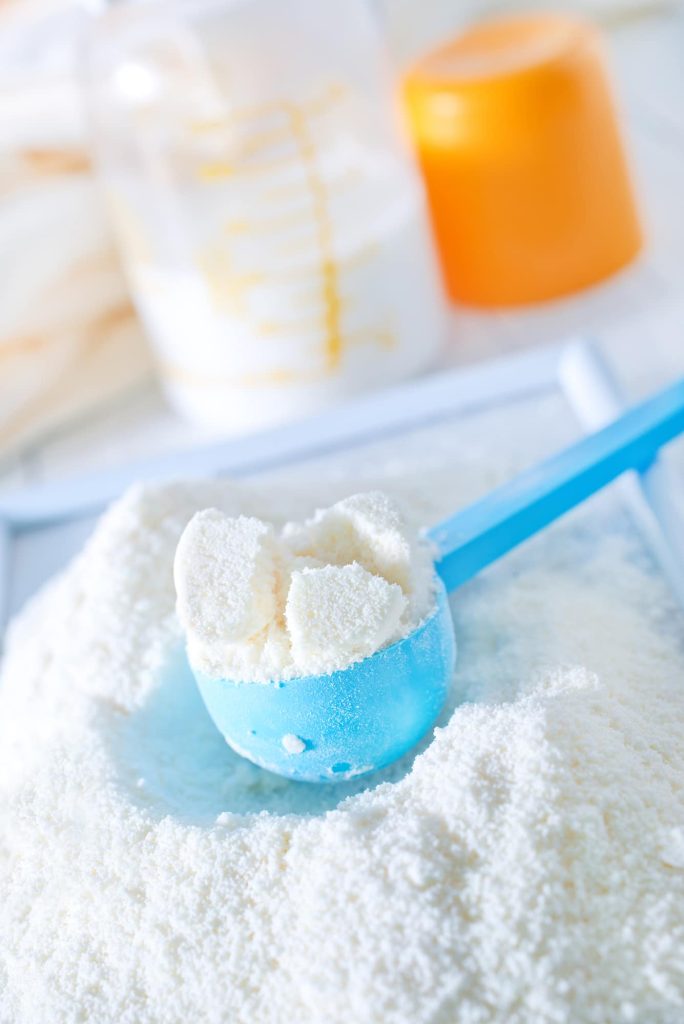Resource &
Knowledge Center
Carbohydrate Ingredients
MILK INGREDIENTS
Whey Ingredients
milkfat Ingredients
Infant Formula (IF) Grade Lactose Standard for Dry Blending
v 3.1 | Effective 08/18/2023

Product Definition
Lactose (Milk Sugar)White to creamy white crystalline product, possessing a mildly sweet taste. It may be anhydrous, contain one molecule of water of hydration, or be a mixture of both forms. It is manufactured from whey or permeate by evaporating, crystallizing, refining and then drying the lactose crystals. More is a white to creamy white crystalline product, possessing a mildly sweet taste. It may be anhydrousWithout water. Example: α-anhydrous lactose is α-lactose that does not contain a molecule of water associated with its structure.; contain one molecule of water of hydration; or may be a mixture of both forms. It is manufactured from wheyLiquid obtained from cheese manufacture. More or permeate by evaporating, crystallizing, refining and then drying the lactose crystals. Lactose for infant consumption complies with all provisions of the U.S. Federal Food, Drug, and Cosmetic Act as well as any foreign regulatory requirements of the nations in which it is consumed.
Composition
| Parameter | Units of Measure | Limits |
|---|---|---|
| Lactose | %, dry basis | 99.0 minimum |
| Protein | %, dry basis | 0.30 maximum |
| Ash (sulphated) | %, dry basis | 0.30 maximum |
| Total moisture (1) | %, as-is basis | 6.0 maximum |
(1) Includes water of crystallizationDevelopment of crystals. Example: Formation of crystals in concentrated whey or permeate More.
Mesh Size
IF Grade Lactose for Dry Blending can be milled to produce various mesh sizes.
Other Characteristics
Physico-chemical Properties
| Parameter | Units of Measure | Limits |
|---|---|---|
| Scorched particles | mg/25g | 7.5 maximum |
| pH | 10% solution | 4.5 - 7.5 |
| Aluminum (Al) | mg/kg | 1.00 maximum |
| Tin (Sn) | mg/kg | 10.00 maximum |
| Arsenic (As) | mg/kg | 0.05 maximum |
| Lead (Pb) | mg/kg | 0.02 maximum |
| Mercury (Hg) | mg/kg | 0.03 maximum |
| Manganese (Mn) | mg/kg | 0.20 maximum |
| Copper (Cu) | mg/kg | 2.00 maximum |
| Cadmium (Cd) | mg/kg | 0.02 maximum |
| Nitrites | mg/kg | 2 maximum |
| Nitrates | mg/kg | 50 maximum |
| Aflatoxin M1 | µg/kg | not detected (2) |
| Quaternary ammonium compounds (BAC & DDAC) | µg/kg | 10 maximum |
| Radionuclides | Bq/kg | 50 maximum |
| Nonylphenol ethoxylate (NPE) | µg/kg | 50 maximum |
| Color | visual | white to cream white powder |
| Flavor | sensory | slightly sweet |
(2) Where the effective limit of quantitation for the test is 0.1 µg/kg (ppb) then the test result must be not detected in order to comply with this Standard. Where the testing method is capable of quantifying the toxin below 0.1 µg/kg (ppb), then a compliant result must be a value less than 0.1 µg/kg (ppb).
Microbiological Analysis
Any microbiological test result, outside of specification throughout a given lot of production, eliminates all product from that lot as IF Grade Lactose for Dry Blending:
| Parameter | Units of Measure | Limits |
|---|---|---|
| Standard plate count | CFU/g | 500 maximum |
| Yeast and mold | CFU/g | 10 maximum |
| Escherichia coli | CFU/g | not detected (3) |
| Enterobacteriaceae | CFU/100g | not detected |
| Salmonella | CFU/1500g | not detected |
| Staphylococcus (coagulase positive) | CFU/g | not detected (3) |
| Bacillus cereus | CFU/g | 100 maximum |
| Clostridia (sulfite-reducing) | CFU/g | 100 maximum |
| Cronobacter sakazakii | CFU/300g | not detected |
(3) Where the effective limit of quantitation for the test is 10 CFU/g (such as when a dilution factor of 10 is applied) then the test result must be not detected in order to comply with this Standard. Where the testing method is capable of quantifying microbial counts below 10 CFU/g, then a compliant result must be a value less than 10 CFU/g.
Methods of Analysis
| Criteria | Reference Method |
|---|---|
| Lactose | ISO 22662/IDF 198 |
| Protein | AOAC 991.20 (N x 6.38) |
| Moisture | ISO 5537/IDF 26 |
| Ash | AOAC 942.05 |
| pH | USDA |
| Metals | ICP-AES |
| Standard plate count | AOAC |
| Yeast & mold | AOAC |
| Escherichia coli | AOAC |
| Enterobacteriaceae | ISO 21528 |
| Salmonella | AOAC or FDA BAM |
| Staphylococcus | AOAC |
| Bacillus cereus | FDA BAM |
| Clostridia | ISO 15213 |
| Cronobacter sakazakii | ISO 22964 |
Product Labeling
Recommended identifications: Lactose or Milk Sugar
Infant Formula Grade Lactose for Dry Blending is specifically suited for use in infant formula manufacturing processes where ingredients are combined “as is” (dry) rather than via rehydration.
Product should be stored, shipped, and utilized according to the manufacturer’s established recommendations. As guidance, product should be stored and shipped in a cool, dry environment with temperature below 80°F and relative humidity below 65%. Stocks should be rotated and utilized in accordance with the manufacturer’s established date of expiration or retest.
Multiwall kraft bags with polyolefin inner liner, or other suitable closed containers (e.g., totes) are typical.
In no event shall ADPI be liable for any direct, indirect, incidental, special, exemplary, or consequential damages (including, but not limited to: the need to procure substitute goods or services; loss of use, data, or profits; or business interruption) however caused and on any theory of liability, whether in contract, strict liability, or tort (including negligence or otherwise) arising in any way out of the publication, use of, or reliance upon any standard, even if advised of the possibility of such damage and regardless of whether such damage was foreseeable.

